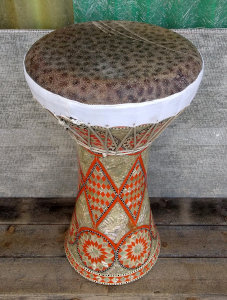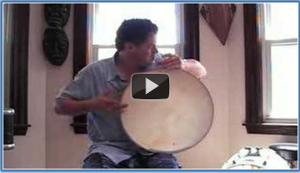Middle Eastern Hand Drums

A Bit of History on Middle Eastern Hand Drums
Religious austerities have led to the occasional banning of instrumental accompaniment throughout the Muslim world, and the Middle East is the heart of the Muslim world. Since rhythm and percussion are fundamental to music, it follows that hand drums have been frowned upon in the Middle East.
There are verses in the Koran that seem to directly warn against the enjoyment of music. Even today, certain types of music are banned by religious edict.
Despite the hurdles placed before it, Middle Eastern hand drumming has advanced to a high level of sophistication. The complex rhythms and playing techniques typical of Middle Eastern drumming are astonishing.
It's a wonder that such simple instruments as hand drums can attain such refined complexity.
As in other cultures throughout the world, percussion plays a central role in Middle Eastern music. Doumbeks, darbukas, dofs, tars, doiras, bendirs and riqs are only a few of the hand drums common to the Middle East and surrounding areas. The incredible variety of these instruments and the materials used in their construction match the rich diversity of cultures from which they originated.

But, regardless of which of the myriad hand drums is played, to Westerners, Middle Eastern drumming conjures exotic scenes of voluptuous belly dancers gyrating seductively around an open fire beneath the desert stars. Their faces veiled. Their frolicking navels fully revealed.
Let's take a look at some of the outstanding drums of the Middle East.
Noteworthy Middle Eastern Hand Drums
Doumbek
The rhythms heard in the previous video were played with a doumbek, also known as darbuka, the 'classic' goblet drum. This instrument is traditionally made of clay or wood and headed with goat or fish skin.
While some claim this is an ancient instrument, there is no evidence to support the claim. Historic evidence such as artistic representations and accounts of the darbuka don't appear until the 19th century. The evidence implies that frame drums, such as tars and riqs, had been the favored rhythm instruments until less than a century ago. The 'classic' Middle Eastern hand drum didn't gain prominence until the middle of the 20th century.
There are two major styles of doumbeks. The Egyptian style has a rounded edge on the the head which makes for a forgiving playing surface. The Turkish style has a sharp edge which makes it easier to utilize some advanced playing techniques because the playing surface is more accessible..

Many of today's doumbeks are tuneable and made with modern materials that include metals like spun aluminum for the body and mylar for the head. The doumbek is extremely responsive, with a crisp, clear sound and a deep, powerful bass. Playing techniques can be extremely advanced and include finger rolls, snaps and pops.
The Persian zarb, or tonbak (tombak), is a larger version of this Middle Eastern drum that is sometimes skinned with camel.
Is your doumbek in need of repair? Please visit our page on Doumbek Repair.
Frame Drums
While some people believe that the doumbek is a newcomer to the middle east, relatively speaking, everyone agrees that the Middle Eastern frame drum has been around for aeons. The frame drum is relatively easy to make and carry around - important considerations for nomadic cultures.
There are four basic types of frame drums found throughout the Middle East and its surrounding areas.
- Tar
- The tar is the oldest and most basic Middle Eastern frame drum, being simply a skin (usually goat) mounted on a shallow hoop ranging from 10 to 22 inches in diameter. A thumb hole is occasionally included in this hand drum.
- Daf (Doira)
-
The daf (def, duff, deff, dof) tends to have a shallower body than the tar, but is thicker and heavier and has rings attached to the frame that jingle when the drum is played. Note that to some people the smaller, or female, version of this drum is known as the doira (dayereh, doyre, doyra, dojra, dajre, doira, dajreja).
Goat skin is traditionally used on the 18"-20" frame. The shallow body and tightly pulled skin results in a sharp, clear voice that makes this ancient instrument popular well beyond the Middle East.
- Bendir
- The bendir will have a deeper body with a thumb hole and have one or more gut sinews attached across the inside of the head that act as snares. The diameter is generally 14"-16", but can be considerably larger or smaller. The use of the bendir has reached areas of North Africa, such as Morocco.
- Riq
- The riq is an 8"-10" tambourine with 5 sets of cymbals and traditionally skinned with goat or fish skin. This popular instrument is used in folk, classical and contemporary music. The versatility of this Middle Eastern hand drum offers ample opportunity for creative improvisation.



As with other Middle Eastern hand drums, frame drums are now also made with contemporary materials. Note that many of the terms used here are interchangeable, depending on the area.